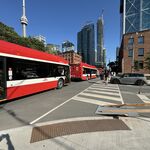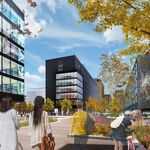Tuscani01
Senior Member
Well, one difference everyone seemed to skip over was the fare cost. 24,000 was under the RER plan, using GO fares. Metrolinx is still studying what Smart Track will do to that number.
Well, one difference everyone seemed to skip over was the fare cost. 24,000 was under the RER plan, using GO fares. Metrolinx is still studying what Smart Track will do to that number.
look ahead to 2031 and show about 77,000 riders per day if trains come every 15 minutes. But that would more than quadruple to about 315,000 a day if the trains run every five minutes.
It shows daily ridership in the range of 12,000. This assumes a change from heavy to light rail along Eglinton Avenue West, fewer stations, a GO fare and trains every five to 10 minutes.
The reports from Metrolinx and City Planning aren't at all incongruent, as Elliot's article may imply to some readers.
City Planning's numbers were a best case scenario, which probably is not be feasible. This is with 25 stations, 55 km, Eglinton West spur and 5 min frequencies. This is cost prohibitive, effectively impossible, to achieve if you believe the various past reports. Apparently this plan has been totally scrapped, as per Elliott's last article.
Metrolinx's numbers were based off a more realistic scenario, and the scenario that City Planning was evaluating in Elliott's last article. This is with 4 or 5 new stations, 5 to 10 min frequencies and GO and TTC fares. With GO fares, daily ridership is 12,000. With TTC fares, ridership is 24,000.
So the findings can be summarized as this: The allegedly impossible version would move 300,000 per day. The more realistic version would move 24,000
A Metrolinx spokeswoman said it was premature to discuss its ridership projections.
“Work is under way, but no outcomes have been confirmed,” Anne Marie Aikins said in a statement. “Our effort is a collaborative one with the city, and we will not finalize any forecasts in isolation from our discussions with the city.”
The reports from Metrolinx and City Planning aren't at all incongruent, as Elliot's article may imply to some readers.
City Planning's numbers were a best case scenario, which probably is not be feasible. This is with 25 stations, 55 km, Eglinton West spur and 5 min frequencies. This is cost prohibitive, effectively impossible, to achieve if you believe the various past reports. Apparently this plan has been totally scrapped, as per Elliott's last article.
Metrolinx's numbers were based off a more realistic scenario, and the scenario that City Planning was evaluating in Elliott's last article. This is with 4 or 5 new stations, 5 to 10 min frequencies and GO and TTC fares. With GO fares, daily ridership is 12,000. With TTC fares, ridership is 24,000.
So the findings can be summarized as this: The allegedly impossible version would move 300,000 per day. The more realistic version would move 24,000
But then Metrolinx when asked about the numbers, said they are not yet final and are still being worked out with the city. So likely to change. I don't think Metrolinx's original numbers were based off the plan city staff will be recommending, at least that's what Anne Marie Aikins seems to be saying.
The reports from Metrolinx and City Planning aren't at all incongruent, as Elliot's article may imply to some readers.
City Planning's numbers were a best case scenario, which probably is not be feasible. This is with 25 stations, 55 km, Eglinton West spur and 5 min frequencies. This is cost prohibitive, effectively impossible, to achieve if you believe the various past reports. Apparently this plan has been totally scrapped, as per Elliott's last article.
Metrolinx's numbers were based off a more realistic scenario, and the scenario that City Planning was evaluating in Elliott's last article. This is with 4 or 5 new stations, 5 to 10 min frequencies and GO and TTC fares. With GO fares, daily ridership is 12,000. With TTC fares, ridership is 24,000.
So the findings can be summarized as this: The allegedly impossible version would move 300,000 per day. The more realistic version would move 24,000
Where are you getting the 24k ridership number? The Oliver Moore article I read only mentioned 12k (with GO fares). Either way, the realistic numbers seem pretty low. I don't even want to consider the 300k number considering how outrageously ridiculous they are, so hopefully Tory won't be bandying that number about tomorrow morning.
There is a massive difference in ridership depending on whether SmartTrack goes every 5, 10 or 15 minutes.
That said, read the description of what Metrolinx modelled in their projection, and compare it to the plan City Planning is expected to endorse, and worked with Metrolinx to formulate. Both plans are very similar.
Another way of saying 24,000 daily ridership is "just over 1/3 of the 504 King Streetcar ridership".That said, read the description of what Metrolinx modelled in their projection, and compare it to the plan City Planning is expected to endorse, and worked with Metrolinx to formulate. Both plans are very similar. Metrolinx projects only 24,000 daily ridership. If so, this is very bad news for Tory. There's not a chance in hell of that being approved.
300,000 per day? Holy hell, if that were true, then SmartTrack would have completely overwhelmed Union Station!
We would be talking about billions of dollars to just upgrade Union Station to handle SmartTrack's capacity, let alone the upgrades needed to actually achieve those levels of frequencies or the Eglinton West tunnel.




